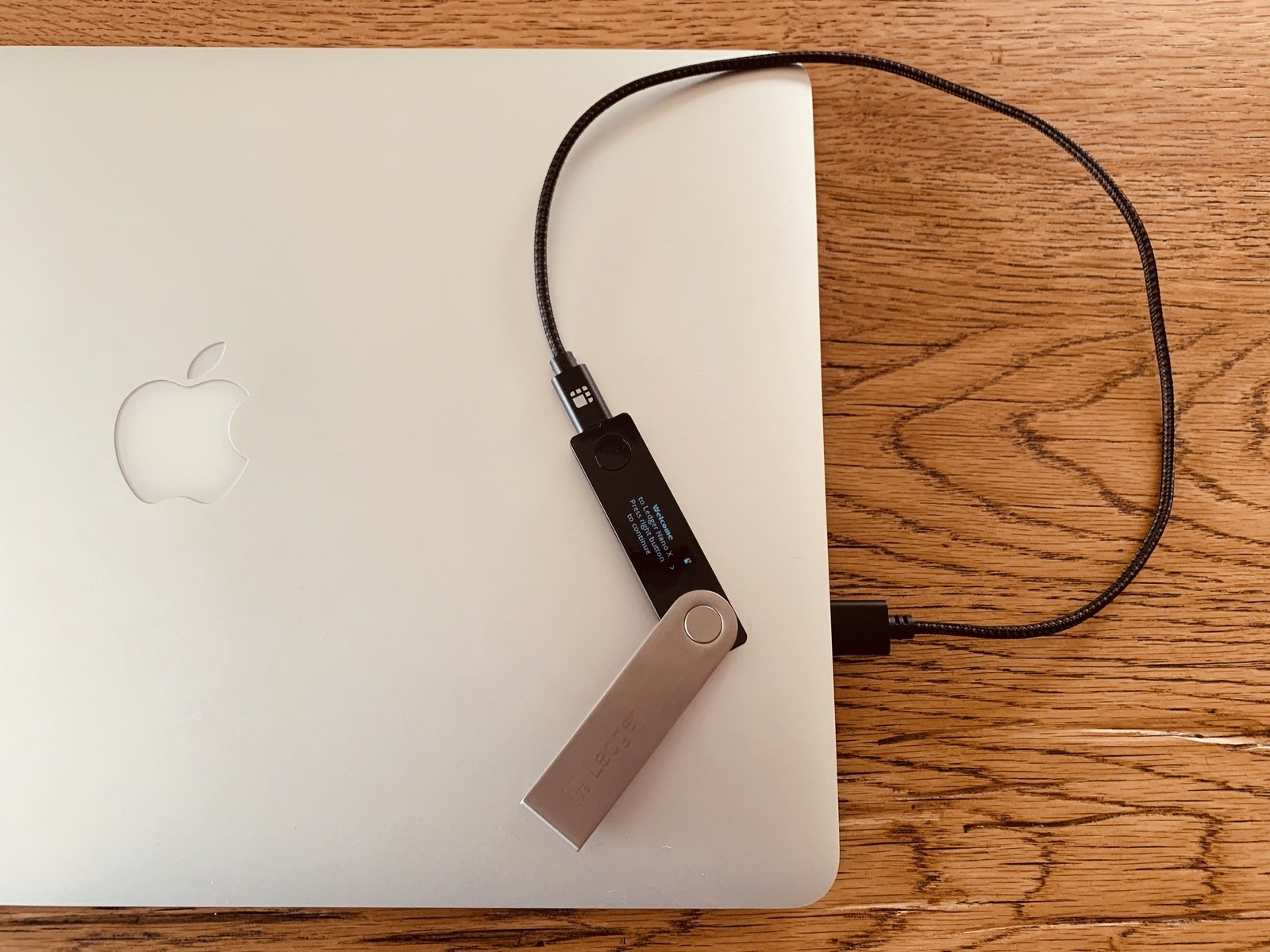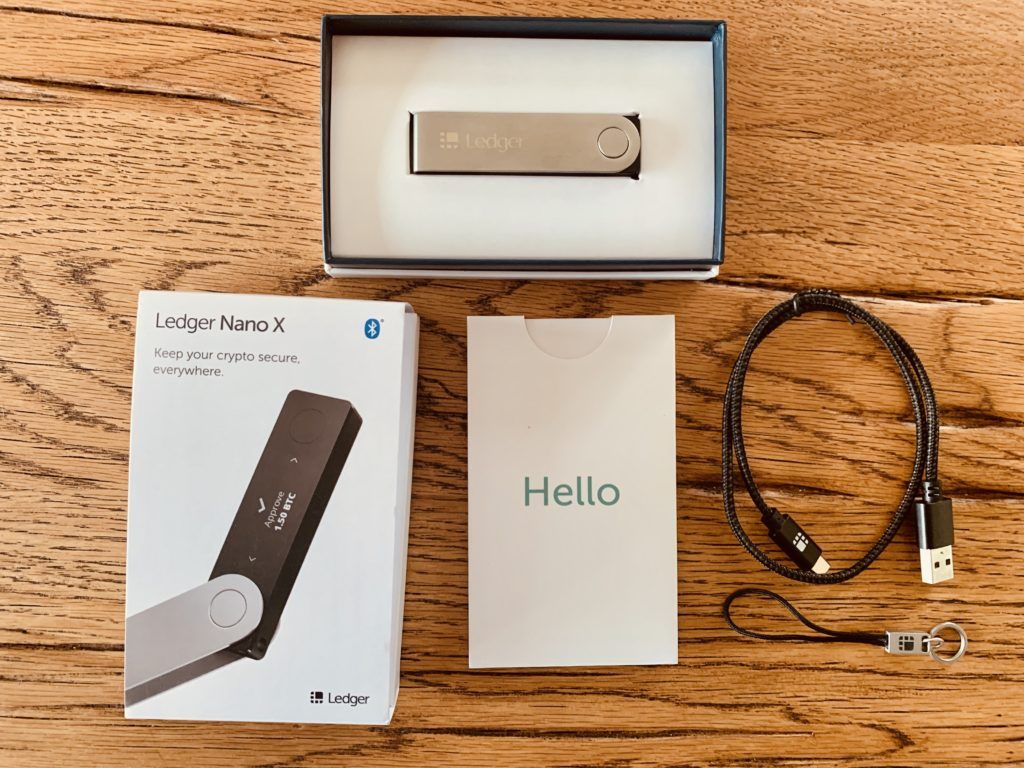The hardware wallet is used for the secure storage of Bitcoin, Ether, Ripple and many other cryptocurrencies.
In terms of security, Nano X meets the same high standards as the previous model, Nano S. However, Ledger has come up with a few ideas to surpass Nano S: The storage for apps is larger, as is the display. Thanks to Bluetooth and an integrated battery, Nano X is also more mobile: With the associated app “Ledger Live”, payments can now also be made on the go via smartphone. More details about the new Ledger generation can be found in the following test report.
Ledger Nano X – First Impression: Chic and Solid
It looks like a pretty USB stick, but can do much more – the Ledger Nano X is here. Visually, it has changed somewhat compared to its proven predecessor, Nano S: It looks more modern, the screen is slightly larger, the control via two buttons has remained the same, but can now be found to the right and left of the display.
Scope of delivery:
- Hardware Wallet
- Keychain
- USB-C cable
- Quick start guide
- Recovery Sheet to note the seed
The Nano X is compatible with all common PC and smartphone operating systems: Windows, Mac or Linux, Chrome OS, Android or iOS, no problem at all. For the first time, the device contains a Bluetooth chip, which can be used to connect the wallet to devices.
There, the coins are managed, sent and received via the Ledger Live app. The app also provides an overview of the stored coins, the balance and its development. Up to 100 different cryptocurrencies can be managed per device – but over 1,100 are supported in principle.
You can order the Nano X from our partner BitConsult, the official Ledger distributor for Switzerland.
What about Security with the Ledger Nano X?
The security of a hardware wallet has top priority. The Ledger Nano S was already able to convince across the board in this aspect and the Nano X is in no way inferior to its predecessor: the hardware is secured by a PIN and the Ledger Live user interface can also be protected with a password. A certification process analogous to the Nano S is also already being planned.
No sensitive data is transmitted via the Bluetooth connection and every transaction still has to be checked and confirmed by the user. If you still prefer to use a cable, you can simply deactivate Bluetooth via the settings.
Private keys, which offer access to the stored cryptocurrencies, are stored in isolation in the Secure Element (a chip integrated into the wallet) – similar to the technology used in credit cards, for example. It is important to know that these private keys are never transferred to the app – neither via Bluetooth nor via cable – but remain on the device and are therefore almost impossible to hack.
Instructions: Setting up Ledger Nano X
The device is switched on by holding the left button down for about three seconds. You will now be prompted to download the Ledger Live software, which also guides you through the configuration of the hardware wallet. The setup itself takes place in four steps:
- First select whether the device is to be configured from scratch or whether the data from the backup (= Recovery Phrase) of another wallet is to be imported. The latter is more convenient, but only works if you already have a wallet and want to switch to the Nano X.
- Then set a PIN code with 4-8 characters and enter it using the two buttons. This code is requested each time the device is switched on. As a matter of principle, the more characters it has, the more secure the PIN is.
- Now the Recovery Seed, which consists of 24 words, is displayed once. They must be noted on the card enclosed with the wallet and kept in a safe place (ideally protected from water damage, fire or theft, but never digitally). Important: The Recovery Seed is the only backup and therefore the only way to access the coins, for example if the hardware wallet is lost.
- To be absolutely sure that the seed has been noted correctly, each of the 24 words must now be selected from a list and confirmed. This takes a moment, but is essential for the reasons mentioned.

Now the hardware is ready for use and can be unlocked with the selected PIN code. A few security questions still need to be answered via the software – another step to ensure that the setup process has worked. Now you can connect the Nano X to a device: To the computer via USB cable, to smartphone or tablet via Bluetooth. For additional security, you should also secure the software with a password – depending on the device, this can even be done easily via fingerprint or face recognition.
Conclusion – this is What Ledger Nano X Can Do
As a hardware wallet, the Ledger Nano X offers particularly good protection against attacks. Cryptocurrencies can be stored securely there and managed easily. The larger app storage and the possibility of managing up to 100 coins in parallel should appeal to many users, but the most convincing features are the battery and Bluetooth. This means that transactions can be carried out for the first time on the go and easily on the smartphone – without becoming vulnerable.
As a rule of thumb for those who are undecided: investing in a hardware wallet is worthwhile if the value of the stored coins is two to three times the wallet price. It is important to pay attention to a reputable seller when buying a wallet, such as bitconsult for Switzerland. This way you can be sure to receive an original, non-manipulated device.
You can order the Nano X from our partner BitConsult, the official Ledger distributor for Switzerland.
Other hardware wallets:

